Thursday 8 AM, I jog from the hotel through the leafy streets of Laureles to the park. It’s my last day in Medellín and I want to go for a swim. Also, it’s my birthday.
At the aquatic center, I ask the attendant if I can swim this morning. He says I need to reserve a lane online two days in advance. That’s impossible; I fly home to New York tomorrow.
He checks his computer and says today is fully booked. But I can wait here on the standby line. First come, first served—no guarantees.
To swim, I need to show a valid passport—the original physical document, not a photo—and wear a Lycra bathing suit and cap.
“I don’t have a cap,” I say. “Do you know where I can buy one?”
“There’s a store around the corner,” he says.
Literally. I walk two minutes around the aquatic center and find a small store selling bathing suits and swim accessories. I buy a black cap for 8,000 COP, about two dollars.
Back at the pool entrance, I ask the attendant where to put my bag when I swim.
“With the lifeguard,” he says.
“Seriously?”
“We have a code.”
“A code of honor?”
“Exactly. Swimmers don’t steal from each other.”
For five days in Medellín, I’ve stashed my phone, passport, credit cards and cash in a travel wallet secured to a belt loop—and shoved down the front of my pants.
Now I’m supposed to trust a stranger to guard my valuables?
In Colombia?
The U.S. State Department warns Americans to reconsider travel to Colombia due to crime and terrorism. Before I came to Medellín, a friend who had worked for the State Department in Bogotá warned me to “keep my head on a swivel” and be mindful of “patterns of organized crime figures targeting tourists, usually drugging them and taking their money.” He elaborated: “You could find yourself talking to a beautiful woman at a bar, thinking the night is going great, and then waking up the next day, sans kidney and wallet.” Another friend—who is married to a woman from Medellín, has visited Colombia often, and encouraged my trip—advised me to be on guard.
Then again, it’s a sunny September morning in the city of eternal spring. This aquatic center has an Olympic-sized outdoor pool. And after an intense immersive week in Colombia, speaking exclusively in Spanish and bonding with locals and tourists, I feel less amped and anxious than when I arrived, more relaxed—and more trusting.
In fact, I learned about this particular pool yesterday from a Venezuelan woman. We met on a group excursion to Guatapé: scaling a 650-foot monolith and riding a boat past the lake house of Colombian soccer star James Rodriguez and the ruins of Pablo Escobar’s infamous vacation home. Later, she told me her boyfriend had recently crossed the perilous Darién Gap, “the strip of land connecting South and North America. It must be traversed to get to the United States from South America by foot. Once rarely crossed, it has become a major migrant thoroughfare in the last three years, with nearly a million people risking the journey since 2021.”
By comparison, losing a passport and a phone at a public pool seems slight.
So I decide to take the plunge.
The attendant recommends sooner rather than later; crowds build as the day progresses.
It’s now 8:30. The next swim session starts at 9:00. There are only three people on the standby line: an older man, a middle-aged woman, and a young guy wearing a t-shirt that says Maratón Medellín. Five days ago, I literally woke up to the city’s marathon, watching the runners streaming down Avenida San Juan in the rain.
“Wait,” I say. “I forgot my goggles at the hotel.”
“Hurry,” the attendant says and promises to save my place in line.
I sprint back through Laureles, grab the goggles from the room, then realize that I forgot to pack my spandex swimsuit, only a floppy pair of floral swim shorts.
When I return to the pool, it’s 8:50 and the standby line is now 10 people long. I ask the attendant if I can wear my running shorts in the pool. He says I need to ask a lifeguard. I jog across the pool deck and ask her. She shakes her head and says they’re not “pegado,” i.e. stuck, which presumably means skintight.
I return to the store around the corner and buy a swimsuit, navy blue with white stripes down the hips, for 40 COP, about 10 dollars.
Back in line, a young woman rolls up on a bicycle, in a red bathing suit and yellow hat with the Colombian national soccer team logo. She cuts to the front of the line, flashes a card, and enters the pool. Presumably she had a reservation.
Another attendant arrives and asks who wants to swim in the Olympic pool. I raise my hand. So does the Maratón Medellín guy. Unfortunately, there’s only one slot available—and he’s ahead of me. Fortunately, there’s space for the rest of us to swim in Escuela 1, a standard-sized pool.
As I enter the pool, I thank the attendant for all his help—and then tell him today is my birthday and that the chance to swim here is a gift.
“Un regalo tremendo,” he says, smiling.
The pool complex is massive. On my way to the locker room, I pass the Olympic pool and separate pools for synchronized swimming, water polo, and lessons for kids, as well as diving tanks with platform and springboard diving boards. Later, after swimming, I’ll sit in the bleachers and watch swimmers and divers, a low-key version of the Summer Olympics.
In the locker room, I stuff my travel wallet in my backpack, wadded in dry clothes.
At the pool, I spot the lifeguard, sitting beneath a shaded tent, surrounded by backpacks hanging on hooks. I hand him my bag. He points me to the center lane.
The pool is portioned into three sections. On the left, physically disabled kids play water polo, each with their own ball. On the right, elderly women with flotation noodles do water aerobics, dancing to a booming salsa soundtrack. In the center are six swim lanes, with eleven swimmers, two per lane. I’m literally the last one. Un regalo tremendo.
The water is warm and clear. The lanes are marked by blue lines along the bottom of the pool, but there are no ropes to divide the lanes. I swim alternating two laps freestyle and two laps breaststroke. Today is more for pleasure than exercise.
At one point, the woman in the next lane swims backstroke, veering across my lane.
When she looks up to orient herself, I make a hand gesture to show she’s off course.
She apologizes, laughing.
“No hay problema,” I say. “Es difícil nadar boca arriba sin ropa.”
Instantly, I catch my mistake. I meant to say it’s hard to swim on your back without lane ropes. Instead I said, it’s hard to swim on your back without clothes.
“Sin cuerdas,” I say, embarassed. “Es difícil nadar sin cuerdas.”
This minor mistake exemplifies the challenge of learning a new language. For years, I’ve been studying Spanish formally, listening to music and podcasts in Spanish, watching movies in Spanish—and reading books in Spanish. But as any language student knows, there is a gap between understanding a language and speaking a language, between the classroom and the real world.
Before coming to Medellín, I met a Colombia-American friend to practice speaking Spanish. Previously, we had conducted our friendship in English. He is bilingual, but was educated in English and now speaks Spanish only to his parents—not to his wife or their kids. During our conversation, we each struggled at times to express ourselves, but then found our way back, via synonyms or circumlocution or analogies, without ever reverting to English. Along the way, we found a new mode of connection, deepening our friendship.
Now, in the pool in Medellín, my lane mate asks if I know the time. She’s a woman in her 30s in a black tank suit and white cap. I don’t know the time; my watch and phone are in my backpack. We start chatting about swimming. She’s a paisa, i.e. person from Medellín, who recently completed a swim training course, designed for adults to improve their technique, speed, and stamina. I tell her I joined an Adult Swim group in New York, training to swim across the Hudson River. I tell her I appreciate this swim because outdoor pools in New York are open for only three months; mine closed last week. She tells me this pool is open year-round. City of Eternal Spring, indeed.
A whistle blows, signaling the end of the hour-long session. We say goodbye, wish each other well. And sure enough, my backpack—with passport, phone, cards and cash—is still with the lifeguard, safe and sound.
Afterward at the pool café, I sip a cup of black coffee, strong, not bitter, and eat a packet of dried pineapples, sweet and chewy. My limbs are loose and my mind is clear.
In the water, in life, the best way to connect with people is to speak their language.
Later, I stop at an ice cream parlor in Floresta and get a free sundae because it’s my birthday. It’s the first—and perhaps last—time I get carded for ordering dessert.

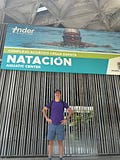


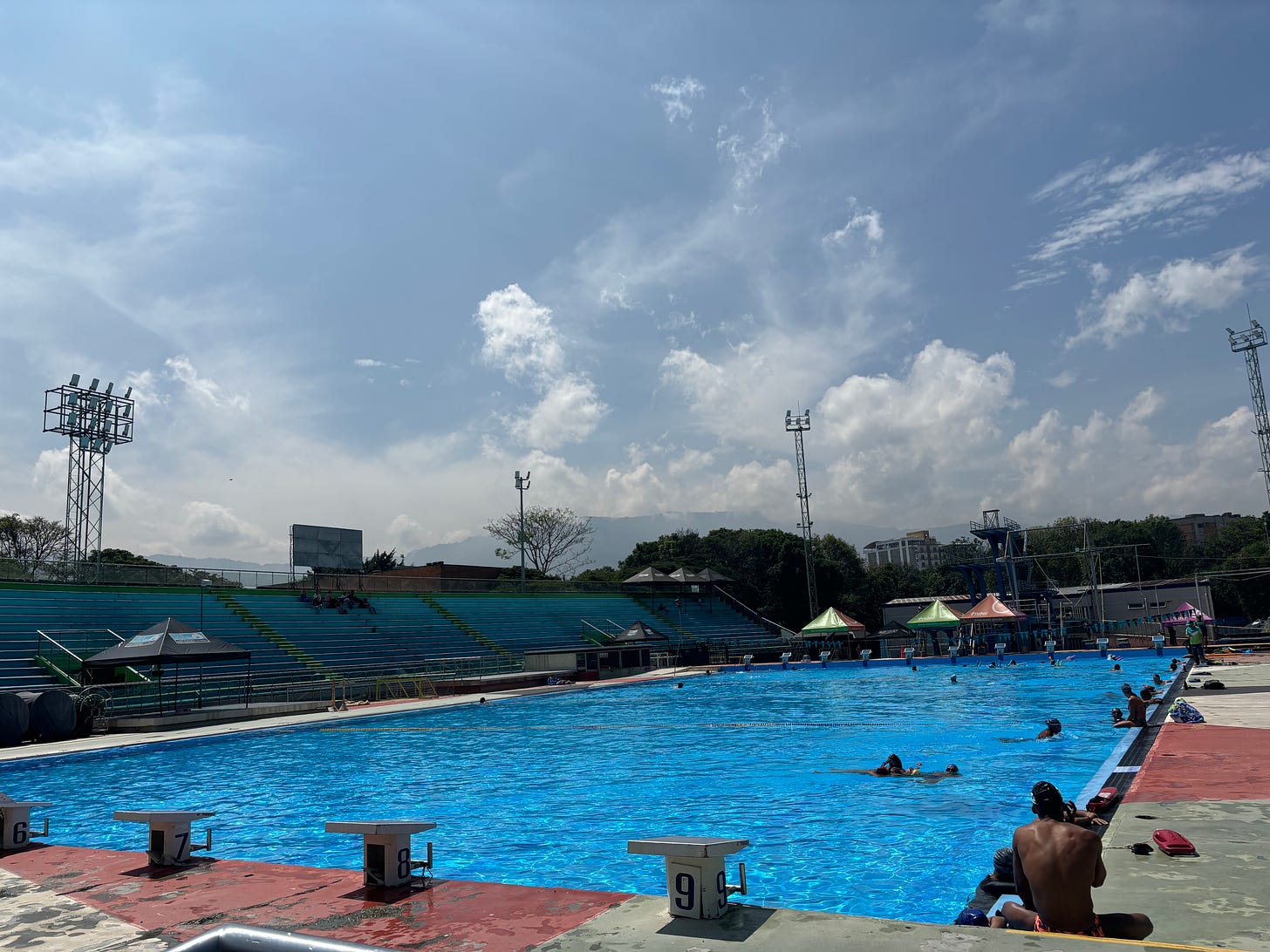
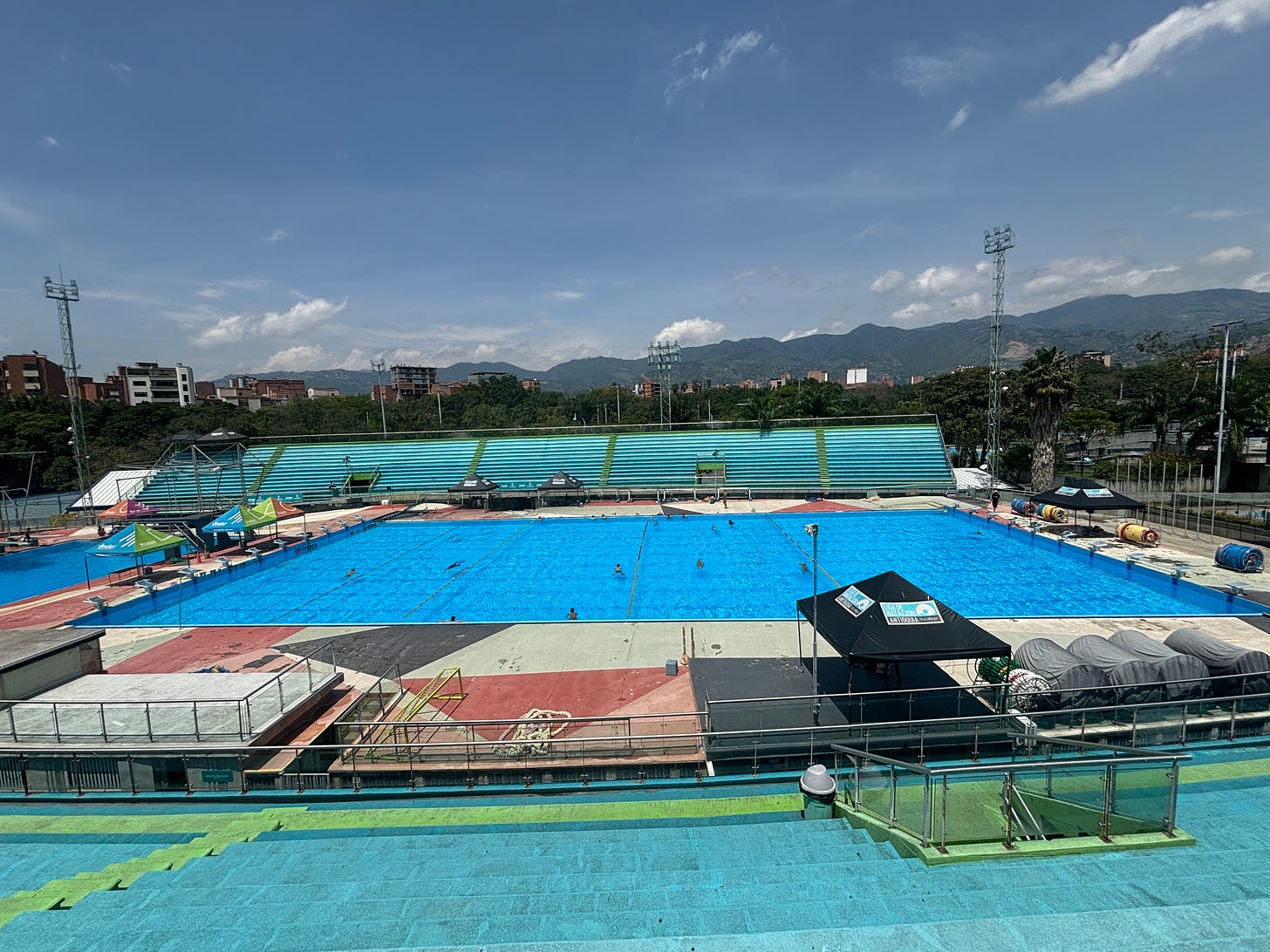
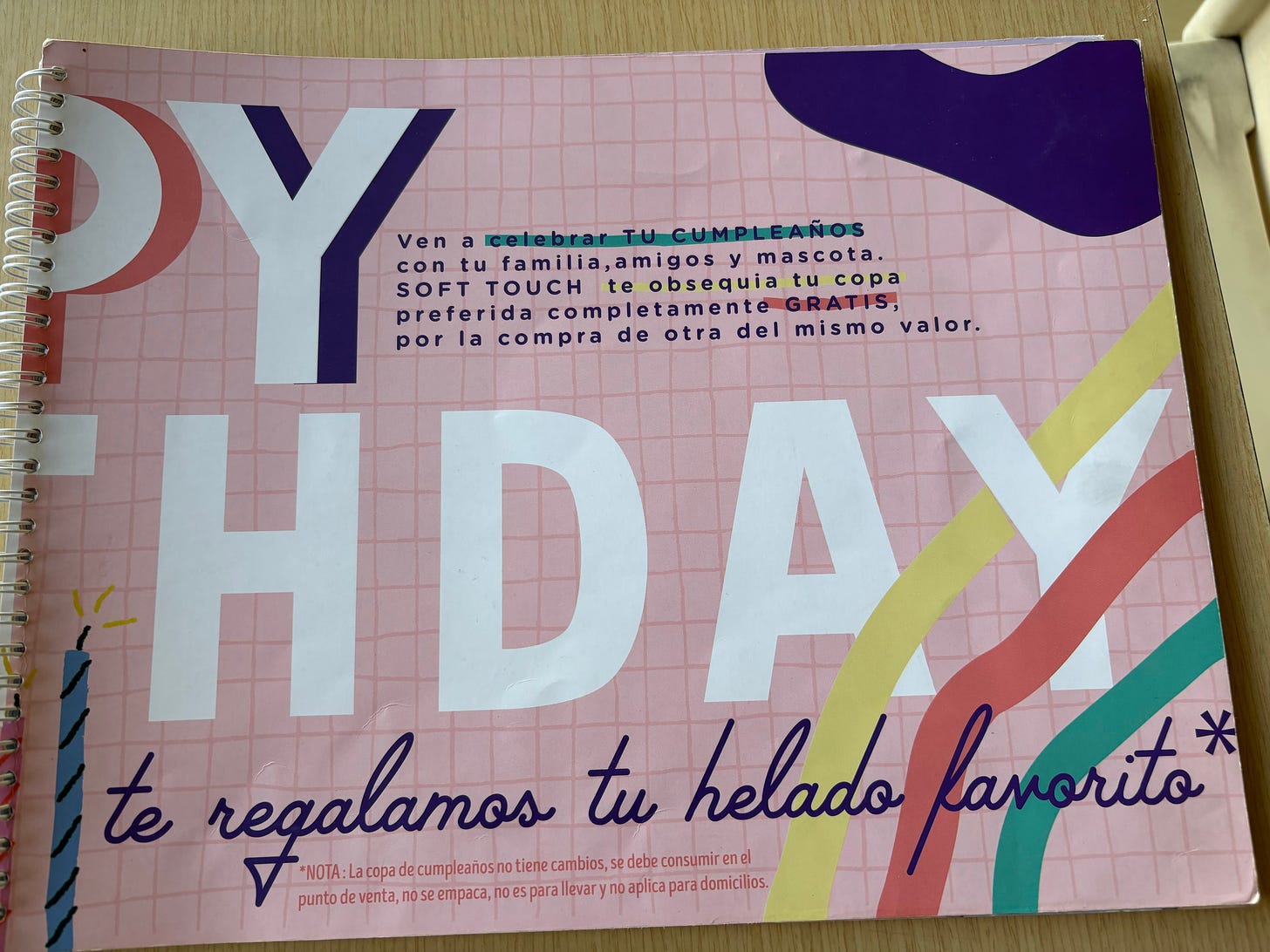
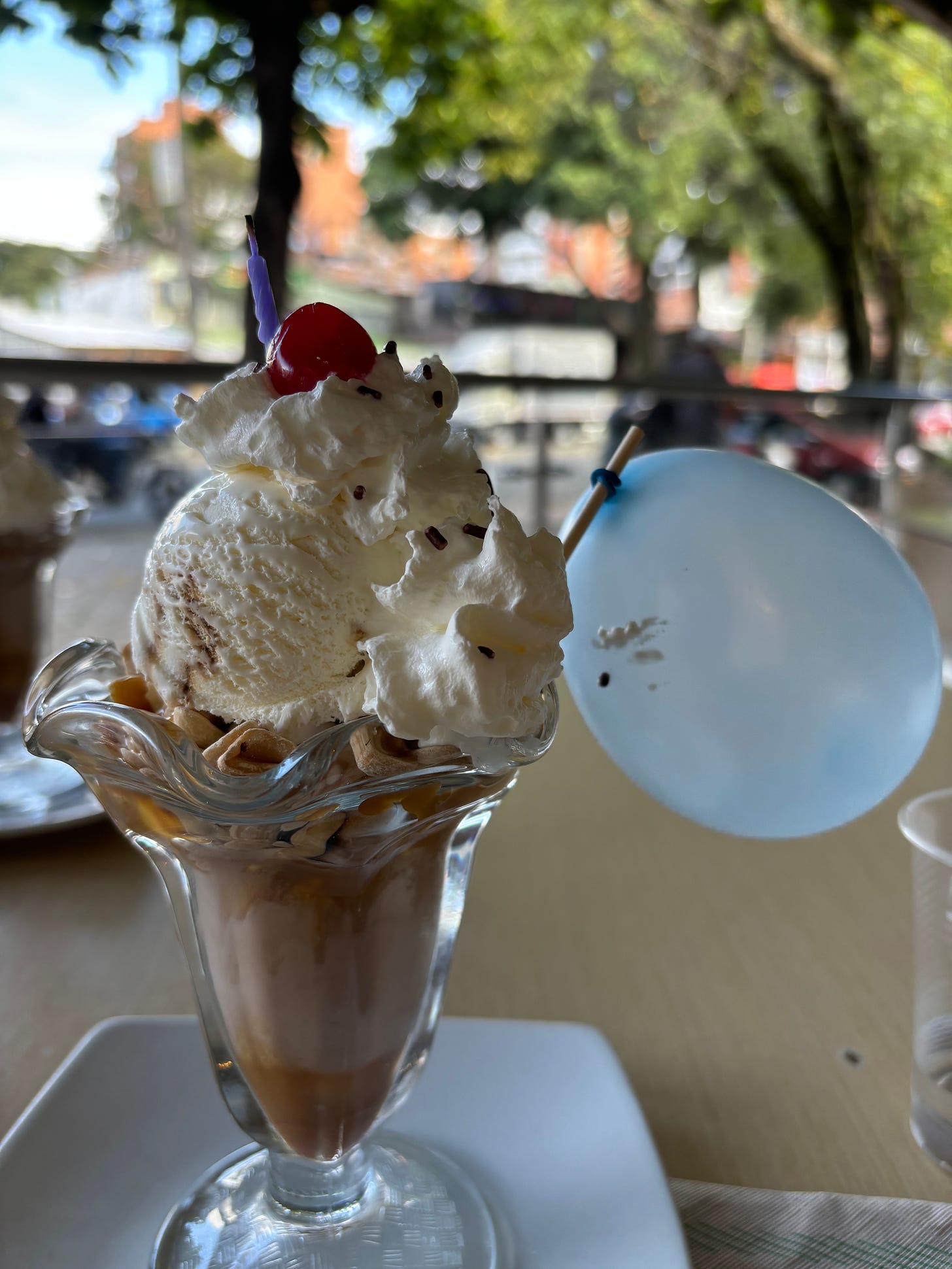
Beautiful story, Keith. Felt like I was there. It's almost as if all those obstacles arose to provide an extra feeling of satisfaction once you finally got in the pool. And, of course, solving all those problems in the moment, in Medellín, highlights the larger accomplishment of learning Spanish!